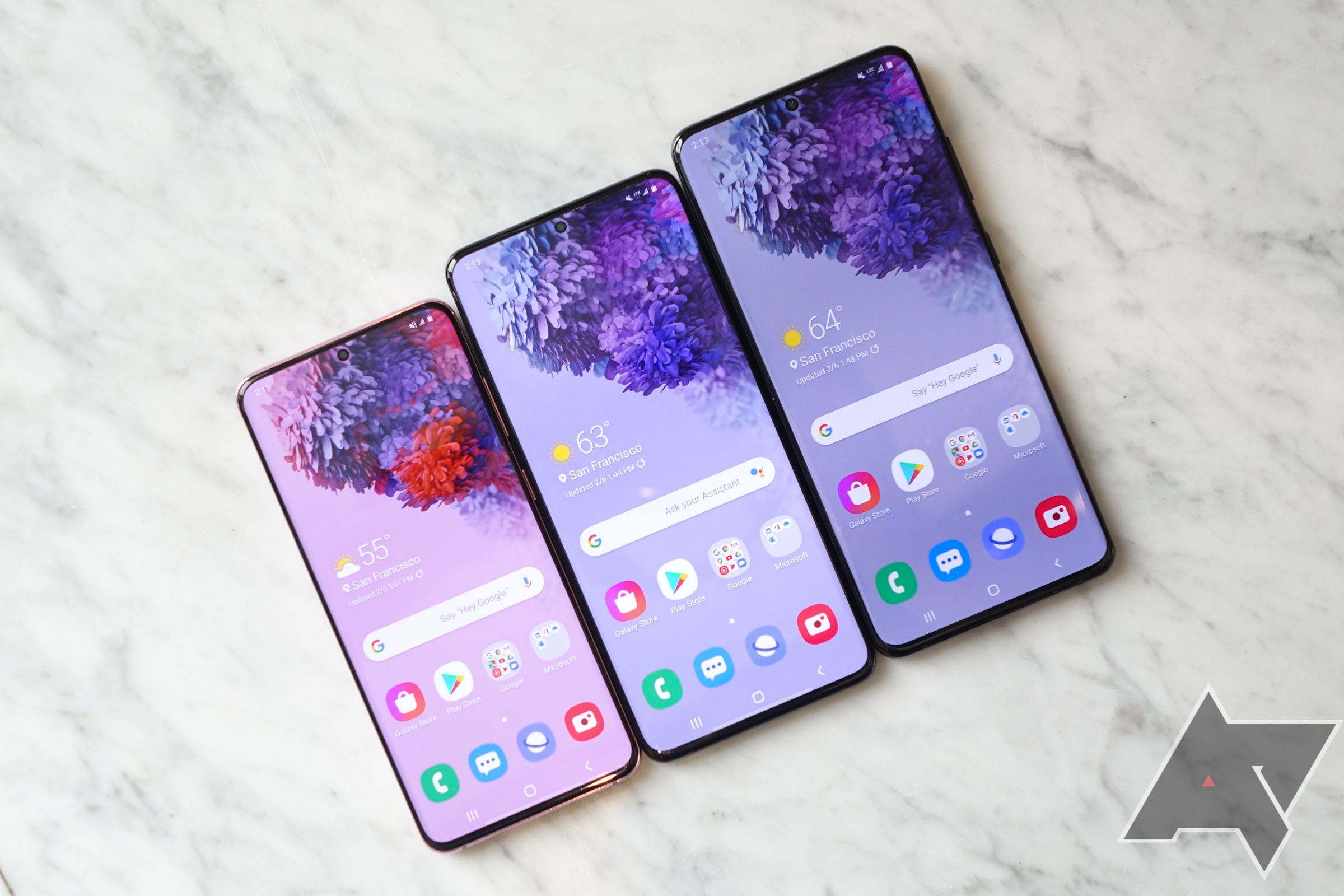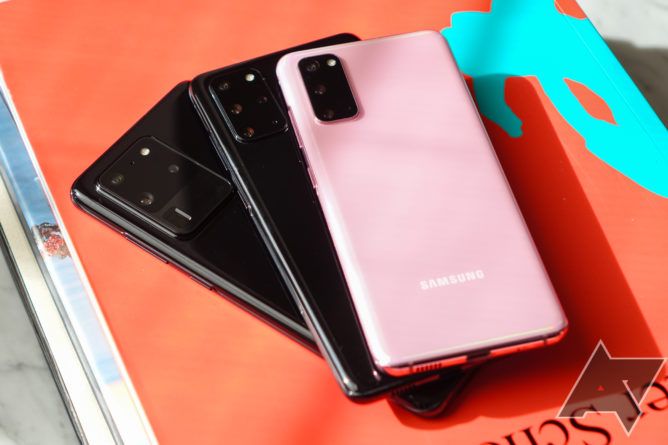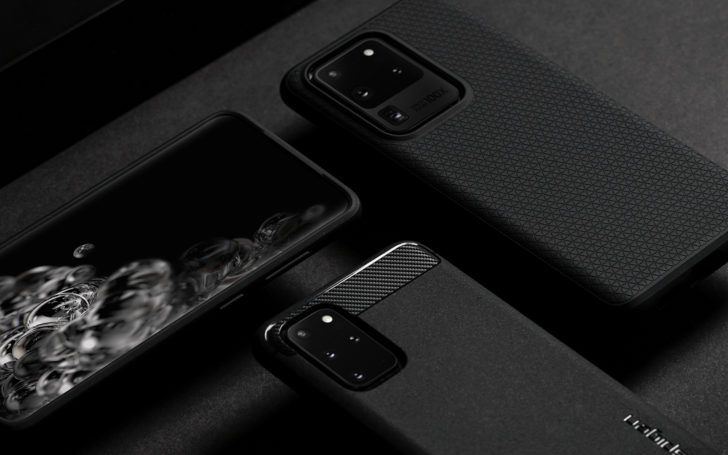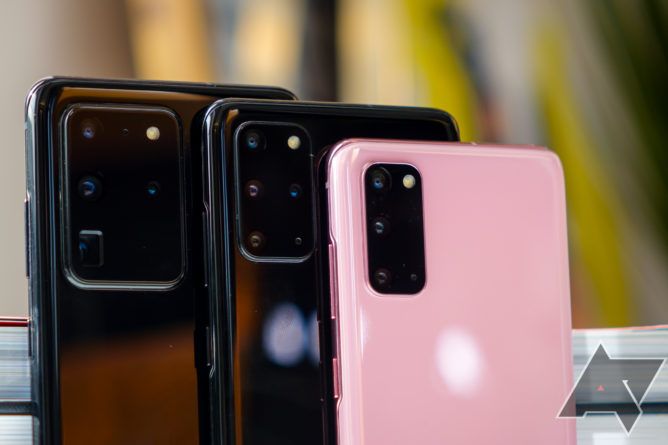The $1000 smartphone is no longer cause for sticker shock: meet the $1400 smartphone, your new "wow" benchmark. That's the price of Samsung's Galaxy S20 Ultra, the range-topping superphone Samsung hopes will one-up Apple in the ongoing battle for Crazy Expensive Phone dominance.
Samsung's other two S20s, the S20 and S20+, aren't cheap, either: the S20 will be $1000, and the S20+ comes in at a still-pretty-eye-watering $1200. Everything about these phones is super-sized: the prices, the rear camera clusters, the 5G support (more on that in a minute), the batteries, and really, the phones themselves. Let's start with that, shall we?
Bigger phones, bigger batteries
Even the baseline Galaxy S20 is sporting a chonking huge battery this year, with 4000mAh of capacity. The S20+ steps that up to 4500mAh, while the gargantuan S20 Ultra is packing 5000mAh. Samsung's motivation here, aside from the obvious (5G and a 120Hz display = moar juice), is almost certainly one of competition. Chinese OEMs like Huawei, Oppo, and Xiaomi have started packing absolutely massive batteries in many of their phones, to be sure, but Apple became the phone world's undisputed battery life king last year with the iPhone 11 Pro Max. I've used the Pro Max extensively, and I have never, ever seen a phone last so long on a charge. Samsung needed to step up its game with battery life this year.
For comparison, the standard Galaxy S20's battery grew 15% (+600mAh), the S20+'s grew around 10% (+400mAh), and even the S20 Ultra's battery is over 10% (+500mAh) larger than the outgoing Galaxy S10 5G's. Those numbers may sound small, but it's not especially useful to think about in terms of proportion: larger batteries mean more screen time on top of the phone's baseline consumption. Whether 5G and the 120Hz displays on these phones will offset those gains remains to be seen, but at least you know they'll have bonkers standby numbers.
Those new batteries did come at a price—thickness and weight—but I imagine that's a price we're all too happy to pay. The S20 phones aren't actually much thicker than the S10s, but that thickness seems to extend farther around the edges, likely creating precious space for those bigger batteries. This gives the phones a kind of chunky feel, but the actual weight gains are in the neighborhood of 5% or so, which nobody is really going to notice. And no: the Galaxy S20 series, even the Ultra, is not made of stainless steel. Samsung is sticking with lightweight aluminum, and as a result, even the monster-size S20 Ultra is still a few grams shy of the much smaller iPhone 11 Pro Max, at 221 grams. While I can appreciate steel's aesthetic and durability, your phone lives in a case all day anyway. Aluminum is fine.
Finally, the last big design change comes in the form of the displays: sweet, merciful DJ Koh, they're finally flat. No more silly, impossible-to-use curved edge displays that just make your smartphone more obnoxious to interact with and much harder to apply a screen protector to. Good on you for this, Samsung. It's the right call.
5G across the board... mostly
5G is a thing, and it's a thing we should talk about. In the United States, all Galaxy S20 models will support 5G on all carriers using a Snapdragon 865 chipset with a Snapdragon X55 modem. There is one asterisk to that, though, because the base S20 does not support mmWave 5G, only sub-6GHz 5G. If you want to understand what that means in any practical sense, I can assure you that it is "not much." mmWave 5G penetration remains statistically negligible in the US, the country with the most mmWave deployment on earth right now, and there's little sign that's changing any time soon. Unless you know you are frequenting a very, very specific venue with 5G mmWave coverage, that technology simply should not enter into your smartphone purchase calculus. It is irrelevant to all but the truest network nerds.
As for the 5G you might actually get to use while owning one of these phones, Samsung says all models on all carriers, including unlocked variants, support every 5G configuration on every carrier in America (including mmWave for the S20+ and S20 Ultra). That's super awesome, and not something I personally expected.
A word from our sponsor: Spigen has once again released a bold case lineup, this time for the all-new Samsung Galaxy S20, S20 Plus, and S20 Ultra. Spigen strives to deliver quality protection packed into a slim frame, wrapped in timeless designs made to last.
Discover cases ranging from bold and sleek, to simple and clear, or strong and classic. Check out the full collection for Samsung Galaxy S20, S20 Plus, and S20 Ultra, now at Amazon.
A dizzying array of cameras—and 100x zoom?
For this section, I'd like to start with the S20 Ultra's new zoom system, because it is a meaningfully different camera system from either the S20 and S20+, and it warrants some explanation. For starters, you won't be able to miss the big "100x ZOOM" text on the back of that massive rear camera module, advertising a capability not found on the smaller S20 and S20+. That comes courtesy of a 48MP "folded" periscope camera with a native 4x zoom factor... which is very much not "100x ZOOM." Allow me to explain. While that periscope camera does get to 4x effective zoom factor on optics alone, everything past that is done via sensor crop (up to 10x), and then digitally (up to 100x).
You can obviously tell what this is a photo of, but it's not something you'd ever want to proudly share and say "look at my 100x zoom camera!"
I'll shoot straight with you: the 100x zoom thing is a real stretch. We were shown some 100x sample photos and I tried out the camera on preproduction software (which almost never meaningfully changes image quality, in my experience), and the images at that level of zoom looked just awful. Yes, you could tell what they were (and that's sort of impressive in and of itself), but Samsung's classic muddy oil painting processing obliterated the details into nothingness. I really think Samsung's marketing people got ahead of themselves convincing the camera product people to allow the S20 Ultra to zoom in this far just so they could say "look, we did it first" when Huawei announces a similar level of zoom on the P40 Pro at MWC later this month. But let's put that 100x nonsense aside, because I honestly believe it really doesn't matter.
The periscope camera appears to perform far better in the 4x-10x range, which is exactly what I want from a system like this. At full 8x zoom, the Pixel 4 XL's Super Res Zoom can struggle in some conditions due to the camera having a "true" optical zoom factor of just 2x. Whereas on phones like the Huawei P30 Pro, I can get consistently usable results at up to 10x. I rarely find myself wanting more than 10x zoom in most conditions, so I tend to feel like everything past that point is just for technical marketing shits and giggles, not real consumer use cases. Also, these periscope cameras have no OIS, so holding the damn phone steady enough to even take a decent image past 10x without using a flat surface or tripod is nigh impossible.
Differences between the cameras on the S20 Ultra and the S20/S20+ are surprisingly large.
The other unique camera the S20 Ultra is packing is an all-new 108MP unit that first debuted on the Xiaomi Note 10 last year. This camera is binned down to 12MP in normal shooting mode, resulting in each imaging "pixel" on the sensor being three times larger than the primary sensor on the Galaxy S10 family (as you could guess, this means the sensor itself is also way bigger). That means more light gathering, which means better performance in difficult lighting conditions. We'll have to test it to really get a feel for this camera, though, and we weren't given many samples to evaluate. This 108MP sensor is also responsible for 8K video capture on the S20 Ultra.
The smaller S20 and S20+ go without the Ultra's folded periscope camera or its 108MP super-sensor. Instead, they have a standard 12MP primary camera and a 64MP secondary sensor, which is used for 8K video and sensor-cropped zooming (with digital zoom up to 30x). All three phones have a rear 12MP ultrawide camera, and the S20+ and Ultra get a time-of-flight sensor for AR stuff. Samsung says the S20 and S20+'s 64MP camera can be used for ultra-high-res shots, but I couldn't find a way to manually select it in the camera app.
The final camera advantage the S20 Ultra sports is a 40MP front-facing unit (binned down to 10MP), while the S20 and S20+ have to live with a 10MP camera. Both are pinhole cutouts in the display.
The early verdict: A (very) large pill to swallow
These are big phones with big prices, and I don't blame anyone for balking at the idea of a massive $1400 smartphone that doesn't, you know, physically fold up its screen to fit in your pocket. These phones are, as the kids say, a lot.
Right now, I'm a little hung up on one thing in particular about the S20 Ultra. It really seems to have received the lion's share—and then some—of the camera upgrades this year. Yes, the S20 and S20+ get their 64MP sensor for 8K video and zoom (which is good!), but Samsung said basically squat about whether the main sensor, ultrawide, or selfie cameras would be appreciably better than last year's. That typically means that, if they are, it's probably not by much. Instead, the $1400 Ultra gets a brand-new main sensor, a brand-new periscope camera, and a significantly upgraded selfie shooter. I'm a little bummed Samsung felt none of this needed to trickle down to the "cheaper" (because seriously, nothing about these phones is cheap) phones. Especially since the S20 Ultra is so ginormous as to be well past the size of smartphone a significant number of people are willing to accept.
But. I am not the person who probably is going to go for anything but the best version of the newest thing on offer. Samsung understands this about its fans: people who are interested in upgrading their technology for the sake of acquiring the very best possible incarnation of the latest and greatest product are willing to pay a premium. And in 2020, it's a pretty dear premium indeed. Questions of whether or not a $1400 phone is "worth it" are kind of silly—is a $100,000 sports car "worth it?" It depends entirely on who you're asking and what your budget is. That's a question for you, not me, to answer.
As for whether or not you should invest in the first real generation of mainstream 5G phones, I can't say I see a big reason not to. 5G is still so new, so sparsely deployed, and such a tiny way past its infancy that buying a 5G phone today probably isn't going to mean you're going to get "left behind" by the 5G of tomorrow. 5G is going to take a long, long time to deploy and fully realize its potential. By the time 5G is really something you need in a smartphone, the Galaxy S20 will probably be well past its prime.
All in all, the Galaxy S20 series is everything we expected. We'll be reviewing the phone some time in the coming weeks, and we'll keep you in the loop on our findings as we can make them available.




